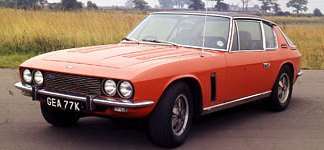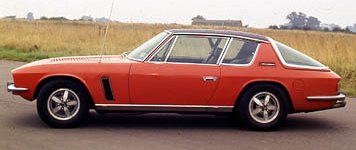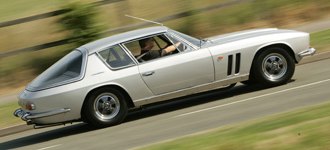  Today few people remember British car maker Jensen. However, back in the 1960s, Jensen produced a luxury grand touring car that raised the eyebrows of Aston Martin and Bentley. It combined the best bits of the world - Italian styling, British craftsmanship and American V8 power. That was Jensen Interceptor. The Interceptor was styled by Italian design house Touring of Milan (which also penned Aston Martin DB4 and Lamborghini 350GT / 400GT). Although its square front end looks outdated now, the rest of the design is elegant, in particular the wrap-around rear glass window which would be copied by Porsche 924 some years later. The 2+2 interior was roomy for front passengers, well equipped and luxuriously trimmed with wood and leather as any good old British luxury cars. After all, it was more expensive than even Aston Martin ! Despite of the high price, Jensen followed the footprints of Facel Vega and AC Cobra to employ an American V8 engine. Before Federal emission regulations tightened in the early 1970s, American high-compression V8s were undoubtedly the most cost effective means to obtain huge power and torque. To a small British car maker without its own engines, what could be wiser than sourcing engines from Detroit ? Chrysler supplied a 383cu (6.3-liter) V8 that could produce 325 horsepower (gross) and 425 lb-ft of torque. It was also very smooth and quiet according to contemporary road tests. In addition to a seamless 3-speed automatic transmission (again from Chrysler), the Interceptor was renowned for effortless performance. Few luxury grand tourers at the time could top 133 mph and sprint from rest to 60 mph in 7.3 seconds. None could achieve that with so little effort from the driver. The only downside was a fuel consumption normally in the range of 12-13 mpg. The chassis of Interceptor was quite outdated for its class, as its rear suspension was non-independent by live axle and leaf springs. This was evident on uneven roads, where it suffered from harsh ride and steering kickback. On smooth highway, however, the Interceptor showed decent handling and good directional stability. During its 10 years life, the Interceptor was updated twice. Mk II from 1969 had minor revisions only. Mk III from 1971-76 had its engine upgraded to 440cu (7.2 liters). The most potent version was Mk III SP (Six Pack), which used three twin-choke carburettors to produce 385 horsepower. In normal driving only the middle carburettor would be used. Under wide open throttle the other two carburettors joined to enable faster breathing. Autocar was impressed by its performance - 143 mph and 0-60 mph in 6.9 sec, although it was less impressed by its non-linear power delivery. Jensen FF However, the most special version among all Interceptors was Jensen FF - so special that its name gave no reference to Interceptor. History books tell us that this was the world's first production road car to feature 4-wheel drive, i.e. 13 years earlier than Audi Quattro. It was also the first to employ anti-lock brakes. It is hard to imagine that a small company like Jensen could make such technical innovations. In fact, its 4WD system was developed by British engineering firm FF Development (which gave its name) and was already tested in Cooper formula one race car. It employed a revolutionary viscous-coupling differential lock to provide limited slip function. In normal condition, 63 percent torque would be transferred to the rear axle so to provide a sports car handling characteristic. When journalists from Motor and Autocar magazine test drove it, they were all amazed by its superior traction that was never experienced before, especially on wet or snow surfaces. Autocar described it as "the safest high performance car yet built". Comparatively, the Dunlop-supplied ABS system was less amazing. It was a pure mechanical design, unlike the computerised ABS that appeared in the 1980s. In those pre-chip age, braking was applied for at most 2-3 times per second, compare with today's 15-20 times per second. However, it still gave the driver the opportunity to steer the car while braking. Despite of its achievement, the FF died in 1971 with only 320 units built. Its high cost was the main reason. The rest of the Interceptor range would survive for 5 more years before Jensen bankrupted. It was the victim of energy crisis, new safety and emission regulations and its own heavy fuel consumption. |